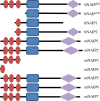Mice, men and the relatives: cross-species studies underpin innate immunity
- PMID: 22724060
- PMCID: PMC3376732
- DOI: 10.1098/rsob.120015
Mice, men and the relatives: cross-species studies underpin innate immunity
Abstract
The innate immune response is the first line of defence against infection. Germ-line-encoded receptors recognize conserved molecular motifs from both exogenous and endogenous sources. Receptor activation results in the initiation of a pro-inflammatory immune response that enables the resolution of infection. Understanding the inner workings of the innate immune system is a fundamental requirement in the search to understand the basis of health and disease. The development of new vaccinations, the treatment of pathogenic infection, the generation of therapies for chronic and auto-inflammatory disorders, and the ongoing battle against cancer, diabetes and atherosclerosis will all benefit from a greater understanding of innate immunity. The rate of knowledge acquisition in this area has been outstanding. It has been underpinned and driven by the use of model organisms. Information obtained from Drospohila melanogaster, knock-out and knock-in mice, and through the use of forward genetics has resulted in discoveries that have opened our eyes to the functionality and complexity of the innate immune system. With the current increase in genomic information, the range of innate immune receptors and pathways of other species available to study is rapidly increasing, and provides a rich resource to continue the development of innate immune research. Here, we address some of the highlights of cross-species study in the innate immune field and consider the benefits of widening the species-field further.
Keywords: toll-like receptor, NLR, pattern recognition receptor, species immunity, immune evolution.
Figures



References
-
- Iwasaki A, Medzhitov R. 2010. Regulation of adaptive immunity by the innate immune system. Science 327, 291–29510.1126/science.1183021 (doi:10.1126/science.1183021) - DOI - DOI - PMC - PubMed
-
- Janeway CA., Jr 1989. Approaching the asymptote? Evolution and revolution in immunology. Cold Spring Harb. Symp. Quant. Biol. 54, 1–1310.1101/SQB.1989.054.01.003 (doi:10.1101/SQB.1989.054.01.003) - DOI - DOI - PubMed
-
- Lemaitre B, Nicolas E, Michaut L, Reichhart JM, Hoffmann JA. 1996. The dorsoventral regulatory gene cassette spatzle/Toll/cactus controls the potent antifungal response in Drosophila adults. Cell 86, 973–98310.1016/S0092-8674(00)80172-5 (doi:10.1016/S0092-8674(00)80172-5) - DOI - DOI - PubMed
-
- Medzhitov R, Preston-Hurlburt P, Janeway CA., Jr 1997. A human homologue of the Drosophila Toll protein signals activation of adaptive immunity. Nature 388, 394–39710.1038/41131 (doi:10.1038/41131) - DOI - DOI - PubMed
-
- Poltorak A, et al. 1998. Defective LPS signaling in C3H/HeJ and C57BL/10ScCr mice: mutations in Tlr4 gene. Science 282, 2085–208810.1126/science.282.5396.2085 (doi:10.1126/science.282.5396.2085) - DOI - DOI - PubMed
Publication types
MeSH terms
Substances
Grants and funding
LinkOut - more resources
Full Text Sources
Other Literature Sources
Molecular Biology Databases
